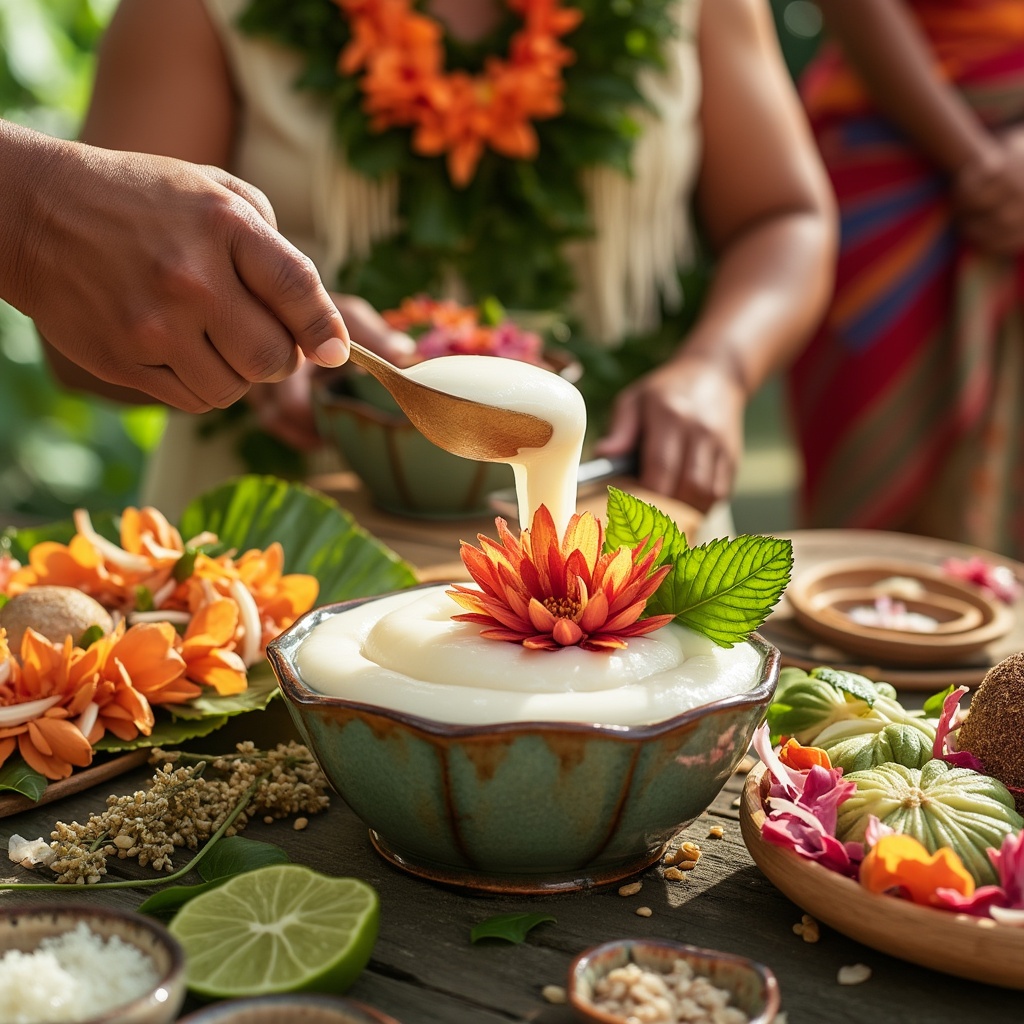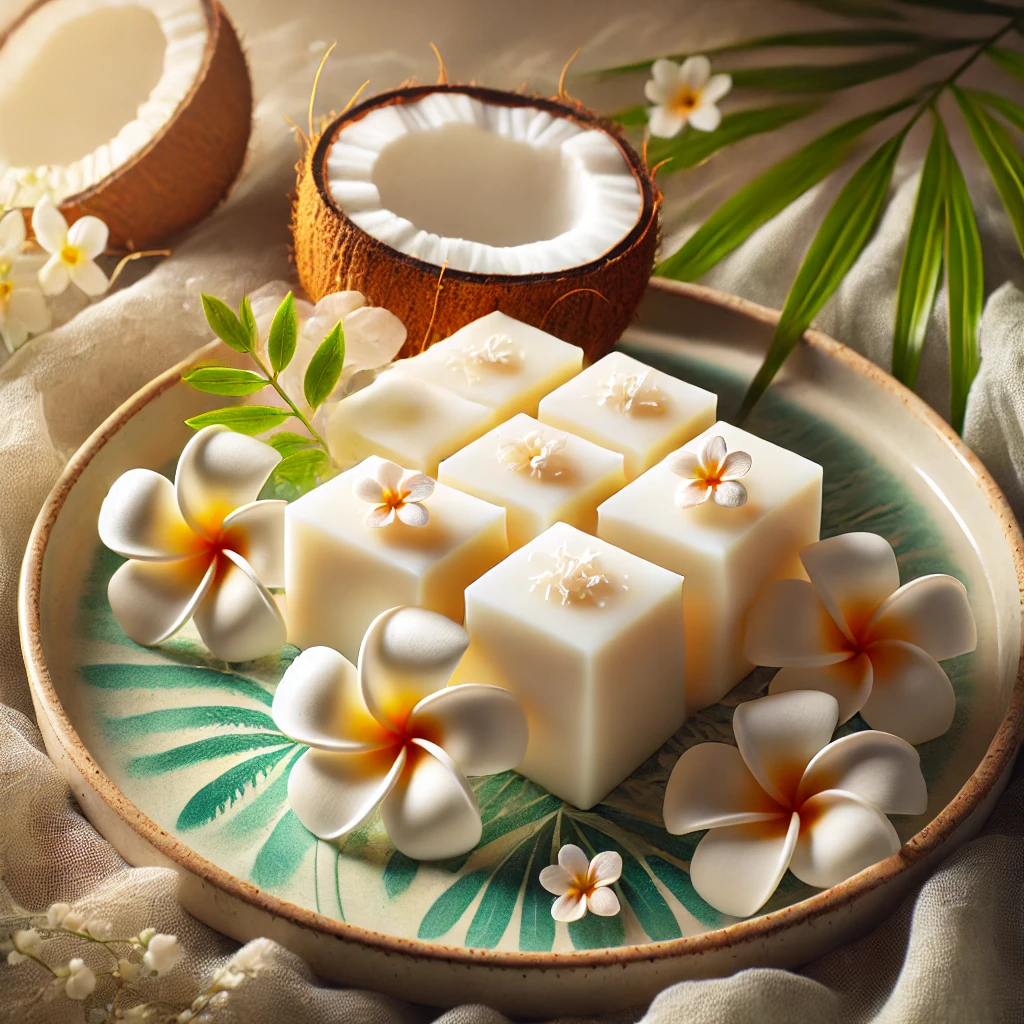Table of contents
Introduction
Hawaiian desserts are a unique blend of flavors and traditions, reflecting the diverse cultural influences of the islands. From the creamy texture of Haupia to the sweet, tangy taste of Lilikoi cheesecake, these desserts capture the essence of Hawaii. Understanding the state dessert of Hawaii not only gives insight into its culinary delights but also its rich heritage and traditions. Let’s dive into the world of Hawaiian desserts and discover what makes them so special.
The State Dessert of Hawaii
Official Designation and History
The state dessert of Hawaii is Haupia, a traditional coconut pudding that has been enjoyed for generations. In 2017, a bill was introduced in the Hawaii State Legislature to recognize Haupia as the official state dessert.
- Legislative Efforts: The move was supported by various cultural groups and the public, highlighting Haupia’s importance in Hawaiian culture.
- Cultural Significance: This designation celebrated Haupia’s delicious taste and acknowledged its historical and cultural significance.
- Symbolism: Haupia symbolizes Hawaii’s rich agricultural heritage and the blending of different cultural influences.
Description and Key Ingredients
Haupia is a simple yet delightful dessert made from coconut milk, sugar, and cornstarch.
- Ingredients: These ingredients are mixed and heated until the mixture thickens, creating a rich, creamy texture.
- • Coconut Milk: Provides the distinct flavor.
- • Sugar: Adds sweetness.
- • Cornstarch: Acts as a thickening agent.
- Preparation: Once set, Haupia is typically cut into small squares and served.
- Cultural Context: This dessert is a staple at Hawaiian luaus and celebrations, reflecting Hawaii’s abundant natural resources.
- • Coconut Palms: Highlighted through the use of coconut milk.
- • Agricultural Bounty: Showcased by the simplicity and richness of Haupia.
Haupia in Modern Times
In modern times, Haupia remains a beloved dessert in Hawaii, featured in both traditional and contemporary settings.
Home Cooking: Many families continue to make Haupia at home, passing down the recipe through generations and keeping the tradition alive.
Restaurants and Eateries: Many local restaurants and eateries offer Haupia on their menus, often adding their unique twists to the classic recipe.
Festivals and Events: Haupia is prominently featured at Hawaiian food festivals and cultural events, allowing both locals and tourists to enjoy its delightful taste.
Haupia: The State Dessert of Hawaii
Historical Background and Cultural Significance
Haupia has deep roots in Hawaiian cuisine, dating back to the early Polynesian settlers who brought coconuts to the islands.
- Polynesian Influence: The Polynesians introduced coconut palms, which became a staple in Hawaiian cuisine.
- Cultural Ceremonies: Haupia has long been a part of traditional Hawaiian ceremonies and celebrations.
- Generational Tradition: Passed down through generations, Haupia is a symbol of cultural continuity and heritage.
Traditional Preparation Methods and Modern Variations
Traditionally, Haupia is made by cooking coconut milk with sugar and cornstarch until it thickens into a pudding-like consistency.

- Ingredients: Coconut milk, sugar, and cornstarch are the main components.
- • Coconut Milk: Provides the base flavor and creamy texture.
- • Sugar: Sweetens the dessert.
- • Cornstarch: Thickens the mixture.
- Cooking Technique: The mixture is heated and stirred until it thickens, then poured into a dish to cool and set.
- • Setting Process: Allowing the mixture to set is crucial for achieving the right texture.
- Modern Variations: New versions of Haupia include flavors like chocolate and pineapple, and it is often used as a filling for pies and cakes.
- • Chocolate Haupia: Adds a rich chocolate layer to the traditional dessert.
- • Haupia Pies: Combines the creamy pudding with pie crusts for a delightful treat.
Haupia in Modern Times
In modern times, Haupia remains a beloved dessert in Hawaii, featured in both traditional and contemporary settings.

- Restaurants and Eateries: Many local restaurants and eateries offer Haupia on their menus, often adding unique twists to the classic recipe.
- Festivals and Events: Haupia is prominently featured at Hawaiian food festivals and cultural events, allowing both locals and tourists to enjoy its delightful taste.
- Home Cooking: Many families continue to make Haupia at home, passing down the recipe through generations and keeping the tradition alive.
Popularity and Reception
Haupia in Hawaiian Cuisine
Haupia holds a special place in Hawaiian cuisine, often featured at local restaurants and eateries.
- Restaurant Menus: It is commonly found on menus at luaus and traditional Hawaiian food spots, celebrated for its simplicity and rich coconut flavor.
- Taste Profile: The dessert’s creamy texture and refreshing taste make it a favorite among both locals and tourists.
- Culinary Significance: Its presence in various dining establishments highlights its importance and popularity in Hawaiian food culture.
- Influence on Other Dishes: Haupia’s influence extends to other Hawaiian desserts and dishes, often inspiring new culinary creations.
How Locals and Tourists Enjoy Haupia
Locals and tourists alike enjoy Haupia in various settings, from casual gatherings to festive events.

- Family Celebrations: It is often served at family gatherings, weddings, and cultural festivals.
- Versatility: The dessert’s versatility and widespread appeal make it suitable for many different occasions.
- Cultural Significance: Haupia’s presence in both traditional and modern contexts underscores its enduring popularity and significance in Hawaiian culture.
- Special Occasions: Haupia is a staple at special occasions, such as birthdays and anniversaries, where its familiar taste brings joy and nostalgia.

Haupia in Media and Pop Culture
Haupia’s appeal goes beyond the kitchen and into various forms of media and pop culture.
Cultural Representations: Haupia appears in books, films, and music that celebrate Hawaiian culture, further cementing its status as an iconic dessert.
Television Shows: Hawaiian cuisine, including Haupia, is often featured in cooking shows and travel programs.
Social Media Influence: Food bloggers and influencers frequently highlight Haupia in their posts, showcasing its appeal to a global audience.
How to Make Haupia at Home
Step-by-Step Recipe
Making Haupia at home is simple and requires just a few ingredients. You’ll need coconut milk, sugar, and cornstarch. Begin by mixing the sugar and cornstarch in a bowl, then gradually add the coconut milk while stirring. Heat the mixture in a saucepan over medium heat, stirring constantly until it thickens. Once thickened, pour it into a dish and let it cool and set. After it has set, cut the Haupia into squares and enjoy!
Tips for Perfect Haupia
To achieve the perfect Haupia, make sure to stir the mixture continuously while heating to prevent lumps. Use high-quality coconut milk for the best flavor and texture. Allowing the Haupia to fully set before cutting will ensure clean, neat squares. Avoid overheating, as this can affect the texture and consistency of the dessert.
Haupia’s Influence on Modern Desserts
Fusion Desserts Featuring Haupia
Haupia has inspired many fusion desserts that blend traditional Hawaiian Desserts flavors with modern culinary techniques.
- Haupia-Filled Pastries: Chefs have creatively incorporated Haupia into pastries, adding a rich, creamy filling to various baked goods.
- Coconut Cream Pies: These pies often feature a Haupia layer, enhancing the tropical flavor with a silky coconut filling.
- Haupia Ice Cream: Combining Haupia with ice cream results in a refreshing and unique dessert, perfect for hot Hawaiian days.
- Highlighting Versatility: These innovative dishes showcase Haupia’s ability to adapt to contemporary tastes while maintaining its traditional essence.
Recipes Inspired by Haupia
Haupia has also influenced the creation of new dessert recipes that pay homage to its classic flavors.
Innovative Treats: These recipes allow dessert enthusiasts to enjoy Haupia in new and exciting ways, bringing fresh perspectives to this beloved Hawaiian dessert.
Haupia Cheesecakes: These cheesecakes blend the creamy texture of Haupia with the richness of cheesecake, creating a delightful fusion dessert.
Layered Haupia Parfaits: Combining layers of Haupia with fruits and other ingredients results in a visually appealing and delicious treat.
Haupia Pies: These pies mix traditional Haupia pudding with pie crusts, offering a modern take on the classic dessert.
Conclusion
The Cultural Importance of Haupia
Haupia is more than just a dessert; it is a symbol of Hawaiian culture and tradition. This simple yet flavorful treat has been a part of Hawaiian celebrations for centuries, reflecting the islands’ history and the influence of various cultures. Its presence at luaus, family gatherings, and festivals underscores its significance in Hawaii’s culinary landscape.
Encouraging Readers to Try Haupia
For those who have never tried Haupia, it is a must-try dessert that offers a taste of Hawaii’s rich heritage. Whether you enjoy it in its traditional form or as part of a modern fusion dessert, Haupia provides a delicious way to experience the flavors of the islands. Embrace the opportunity to create this dessert at home and share it with friends and family, bringing a piece of Hawaiian culture to your table.
FAQs about Haupia and Hawaiian Desserts
Q: What is Haupia?
A: Haupia is a traditional Hawaiian dessert made from coconut milk, sugar, and cornstarch. It’s a creamy, pudding-like treat typically served in small squares.
Q: What does Haupia taste like?
A: Haupia has a rich, creamy coconut flavor with a smooth, silky texture. It is sweet, but not overly so, making it a refreshing and delightful dessert.
Q: How is Haupia traditionally prepared?
A: Traditionally, Haupia is prepared by cooking coconut milk with sugar and cornstarch until it thickens. The mixture is then poured into a dish to cool and set, after which it is cut into squares and served.
Q: What are some modern variations of Haupia?
A: Modern variations of Haupia include flavors like chocolate and pineapple. It is also used as a filling for pies, cakes, and other desserts, allowing for creative and delicious twists on the traditional recipe.
Q: Can I make Haupia at home?
A: Yes, Haupia is easy to make at home with just a few ingredients. You will need coconut milk, sugar, and cornstarch. Simply mix and cook the ingredients until the mixture thickens, then allow it to set before serving.
Q: Where can I find Haupia in Hawaii?
A: Haupia is commonly found on menus at Hawaiian luaus, traditional food spots, and local restaurants. It is also often featured at Hawaiian food festivals and cultural events.
Q: Is Haupia served on special occasions?
A: Yes, Haupia is often served at family gatherings, weddings, and cultural festivals. Its versatility and widespread appeal make it a popular choice for various celebrations.
Q: How does Haupia reflect Hawaiian culture?
A: Haupia reflects Hawaiian culture through its use of coconut, a staple in Hawaiian cuisine, and its presence at traditional ceremonies and celebrations. It symbolizes Hawaii’s agricultural heritage and the blending of different cultural influences.

